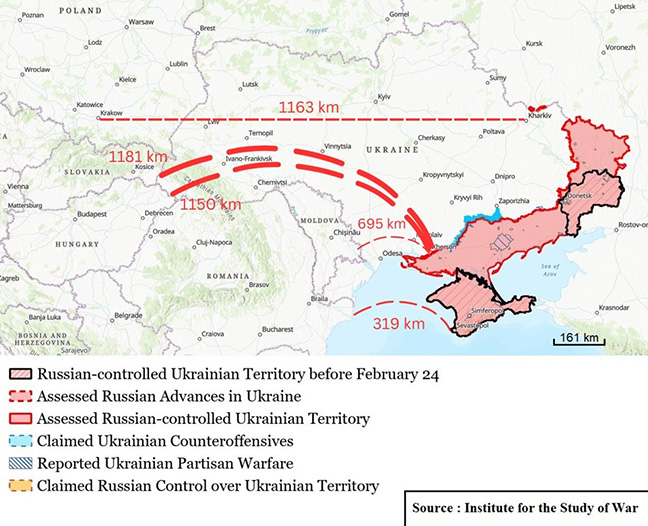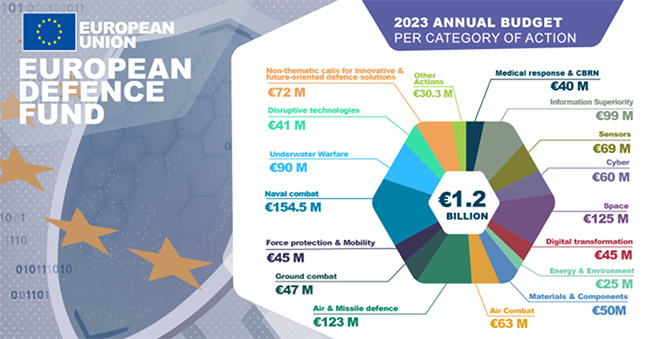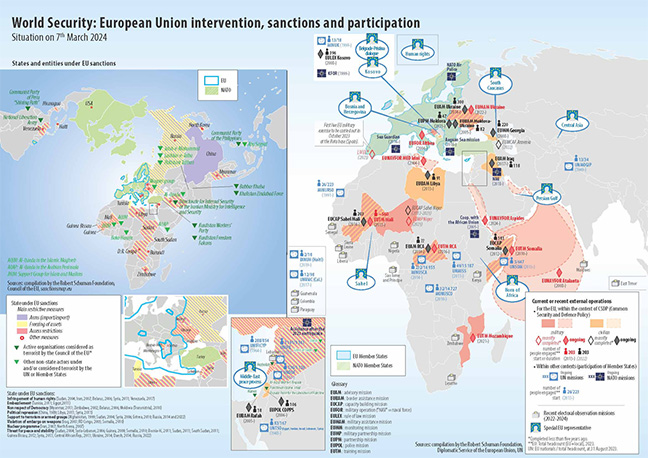Strategy, Security and Defence
Iris Herbelot
-

Available versions :
EN
Iris Herbelot
Lecturer, Institut National Supérieur du Professorat and Education, specialist of European Studies, Université de Paris Nanterre
On 1 October, former Dutch Prime Minister Mark Rutte takes over from Norwegian Jens Stoltenberg as Secretary General of NATO. Known for his political staying power and firm stance on the Kremlin, Mark Rutte will have to pursue the organisation's major projects: support for Ukraine, new members, European budgets, to name just a few examples. It is true that the United States has increasingly been a key player in NATO's defence policy. And admittedly, the United States is increasingly turning its attention to tensions in Asia and the Indo-Pacific region, but NATO's priorities remain very much European. With the ongoing hot war in Ukraine the construction of a European Defence system has not received as much attention and effort since the project for a European Defence Community (EDC) in the 1950s[1].
Distance between Russian troops stationed in Ukraine and countries bordering Ukraine (Romania, Moldavia, Hungary, Slovakia, Poland) Data OpenStreetMap, entered in the Mapbox imaging generator on MapTools, integrated into the interactive map of Institute for the Study of War updated on 31 July 2024, before the Ukrainian counter-offensive in the region of Kursk.
Now is not the time for failure in terms of building one’s own security; and the European Union can no longer afford it. With the existential threat of Russian invasion on its doorstep, the disinterest of its American ally, and Donald Trump vying for a return to the White House: the European Union must be able to rely on itself and learn the lessons of 75 years of Euro-Atlantic relations. It is therefore reasonable to imagine that the new Secretary General of NATO will not be opposed to this and will use all his expertise to guarantee healthy relations between the European Union and the Atlantic Alliance.
The challenge of Europeanising money and equipment
Since the Russian invasion that began in February 2022, Ukraine has repeatedly asked for military aid from Western countries, primarily from the United States and the European Union. This aid has come primarily in the form of equipment for the defence of Ukrainian territory not occupied by Russia and for counter-offensives by the Ukrainian army to regain control of the occupied territories. However, states must also ensure they do not deplete their own reserves, and even that they increase them, which means industrial production must respond to a relatively sudden and costly increase in demand.
To start with, the European Defence Fund (EDF), bailed out by the Extraordinary European Council on 1 February 2024 to the tune of €1.5 billion, is not enough to cover the expenditure required for grouped purchases (by way of comparison, France's legislation on 2023 military spending programme (LPM) has allocated €413.3 billion for the period 2024-2030). Moreover, delays in the delivery of the ammunition promised to Ukraine (less than 50%) are now putting pressure on the European states, which currently face low production capacities.
Annual EDF Budget, 2023, per category.
The industrial and technological base of European defence is still inadequate and the reticence of countries such as Germany with regard to joint borrowing, to support the development of the European defence industry, illustrates the obstacles to the implementation of the European Commission's proposals. In addition, the question of using the interest on assets frozen and confiscated from Russian oligarchs close to Putin in Europe to finance munitions purchases is also running into opposition, this time from the Union's historically neutral countries (Austria, Malta) which prefer to spend money on civilian activities. This disagreement over the European defence budget and joint procurement, as well as the financing of a defence budget, promises stormy debates in the future, especially when Ukraine is no longer the driving force behind the urgent need to build a defence industry, and if not a common one, then at least one that is coordinated.
Faced with the challenge of its strategic survival, the European Union has never been as intergovernmental as it is today on financial and defence issues. With a view to seeing the emergence of a coherent, common European defence, the Member States should therefore agree on what the neutrality status of some of them implies when the European Union chooses to support a country at war (such as Ukraine) or to conduct European military operations (such as operation Irini). Until now, the idea has been to make the resources of the Member States available for action under the European flag, but the question of a European system of defence, with its own capabilities and directed by the Union, has emerged and seems insurmountable beyond the already controversial stage of joint procurement for national armies, which would nevertheless enable considerable economies of scale to be achieved.
Schuman Report on Europe, State of the Union, 2024, p. 49.
Despite the recurrent criticism of its ally on the other side of the Atlantic, there is nothing ridiculous about European defence budgets: combined, the military budgets of the twenty-seven Member States totalled $312 billion in 2023, the second largest military budget in the world after that of the United States ($916 billion), and ahead of China ($296 billion) and Russia ($109 billion)[2]. In relation to its population of 449 million, the European Union therefore has the potential to become a truly global military power. The problem lies in an overly weak level of interoperability, the pooling of the 27 European armies. To Europeanise equipment, we need to Europeanise spending and industrial production. In other words, going further than what is known under NATO.
The European challenges of a hitherto Atlanticist European defence system
The lack of interoperability between armies is just the tip of the iceberg comprising two major problems facing European defence. Chiefly, the EU buys from non-European companies: between June 2022 and June 2023, 78% of procurement expenditure was made with non-European suppliers, 63% of which were from the United States, according to the Draghi report, which together means that when Member States organise themselves and cooperate, the results are positive. Furthermore, the European Union is dependent on American military protection in the event of a conflict threatening its territory, relying on its historic Cold War ally within NATO. For the time being, therefore, European defence is not European at all, underlining the rather (still) too crucial role of NATO and the Americans.
In response to these challenges, the European Commission published on 5 March 2024 a draft law for the establishment of a European defence industrial strategy (EDIS) which provides for the introduction of quotas for the defence industry. It obliges industry and the Member States to pool a minimum of 40% of their equipment purchases between now and 2030, which bodes well for greater use of the EDF.
To strengthen the European defence industrial base, a minimum of 50% of equipment purchased will have to be manufactured in Europe, rising to 60% by 2035. The Commission therefore intends to push Member States towards joint and European procurement. Another interesting aspect of these joint purchases would be to move towards a standardisation of equipment in European armies, ultimately enabling improved interoperability between national armies in theatres of operation under the European flag.
For her second term in office, Ursula von der Leyen, President of the Commission, is seeking to Europeanise European defence issues with the creation of the office of a Defence and Space Commissioner, assigned to former Lithuanian Prime Minister Andrius Kubilius. In this way, the Commission could ease the mobilisation of the EDF for grouped purchases, finance the development and creation of production lines, and select research and development projects focusing on breakthrough technologies, to which 5% of the fund must be devoted under the permanent structured cooperation (PESCO). Empowering the Commission might facilitate coordination between Member States but would not make the European Union sovereign over military spending as it may.
Rather than a new Commissioner, Luigi Gianniti, Director of the Italian Senate's Studies Department, has put forward the idea of strengthening the role of the High Representative for Foreign Affairs and Security Policy (HR/VP), a role that will be filled in the new Commission by the former Estonian Prime Minister, Kaja Kallas, taking over from Josep Borrell. There is already a department dedicated to European security within the European External Action Service (EEAS). By multiplying the number of posts devoted to the European Union's security and defence issues therefore runs the risk of complicating the hierarchy of actors responsible for these questions, leading to confusion between institutional and private interlocutors. Henry Kissinger's apocryphal quote about ‘Europe's telephone number’ also hangs over European defence.
The future of European defence: within or outside NATO?
Given Washington's reluctance - preoccupied with other domestic issues and the Asia-Pacific region - to unconditionally support and guarantee Europe's security, the European Union has had to roll up its sleeves. Dependence on one state is never healthy, as Germany's energy crisis over its dependence on Russian gas has shown. And security dependence, even when the United States is an ally of the Union, is certainly not a safe bet. NATO's security umbrella is too thin for Europe to shelter entirely under, but the growing investment in defence by Member States should convince the US that Europe is once again taking its security seriously and shouldering its share of the burden[3].
But does the future of European defence lie within NATO? The accession of Finland and Sweden to NATO in April 2023 and March 2024 respectively argues in favour of organising European defence within the transatlantic organisation.
France, a major industrial player in European defence and the sole holder of the nuclear shield in the European Union since Brexit, is seeking to assert itself as a driving force behind European defence, as shown by Emmanuel Macron's speeches advocating joint borrowing for European military spending, as well as the fact that French deterrence, which is based on the possession of a nuclear arsenal, includes a European dimension, meaning that its membership of the European Union and therefore the security of its partners is part of its national interests. The return of the Labour Party to office in the United Kingdom, more inclined to foster a security pact with the Union, also encourages taking advantage of the NATO and EDIS frameworks.
However some European states are not NATO members and because ― unlike Sweden and Finland, which have done a U-turn on their neutral status in the face of the Russian threat in the Baltic Sea since the invasion of Ukraine ― they do not share borders with Russia are unlikely to feel the need to join NATO. Convincing them to participate in the organisation of a European defence industry would therefore be one thing; convincing them to participate in a European defence strategy, a fortiori within NATO, would be quite another.
However, the integration of Sweden and Finland immediately marked a more European approach to investment by Scandinavian countries in European cooperation. Even before the Hungarian Parliament ratified Sweden's entry into NATO, on the occasion of a visit by the French President to Sweden in January 2024, France announced the wish on the part of the two countries to sign a declaration of intent regarding air defence and air surveillance systems. The collaboration between the Swedish and French defence industries in the development of the Akeron anti-tank missile is a first step towards European industrial cooperation. The Swedish company Saab (manufacturer of the Gripen fighter jet) has also been signing delivery contracts with other European countries in recent months, including Hungary. Recent progress in strengthening missile defence at European level is very encouraging.
European defence capabilities, even if developed within NATO, will eventually have to be mobilised independently of the organisation. "What seems to be missing is the need to demand at the supranational level of the Union the development of a common procurement policy", stresses Stefano Pontecorvo, Chairman of Leonardo. But here again, the multiplication of hierarchies and players raises questions about the responsiveness and fluidity of military and industrial capabilities. For example, will European spending count towards the 2% share in the GDP allocated to the military budget in accordance with NATO precepts? And what about redundant communication channels, first bilateral, then within NATO, then within the European Union?
Maxime Lefebvre explains why it is in Europe's interest to assert itself more as a major power, and to do this, it is necessary to bypass the Union's political divisions over security decision-making. In his view, unlike NATO, the European Union still lacks a real headquarters capable of planning military operations.
Within NATO itself the states of Europe are divided. For example Hungary enjoys an “opt-out clause” regarding support for Ukraine. A thorn in the side of the West within both the EU and NATO, the Hungarian Prime Minister has once again managed to irritate. While this downward revision of investment by NATO Member States is worrying in terms of support for Ukraine, it does offer a glimpse of a solution for those European States that would like to retain their neutrality while European defence is created within NATO.
The appointment of Mark Rutte as head of NATO does, however, highlight a tendency for the Atlantic Alliance to maintain an interdependence between countries located in the west, i.e. west of the former Iron Curtain. At a time when the Baltic States, Finland and Poland are on the front line of the Russian threat, it is essential to give greater weight to Central and Eastern Europe. Romanian President Klaus Iohannis was a candidate for the NATO General Secretariat for a time, but finally dropped out. By strengthening the role of Estonian Kaja Kallas, in the post of HR-VP, or that of Lithuanian Andrius Kubilius who will be inaugurating the European defence portfolio, the EU's security will be enriched by the experience with the vision of those who claim to be most under threat.
Further east: Asia-Pacific and China
If the distance between the Ukrainian front and the United States, and a possible return of Donald Trump to the White House in January 2025, are two equally valid arguments that should push the European Union to mobilise the European branch of the integrated command and rid itself of its dependence on the American ally, the latter's interest in China and the security issues in the Asia-Pacific region has led the Union to take a greater interest in this region. China does not just represent a growing threat to its neighbours (Taiwan for example). The Chinese Communist Party's massive and growing investment in its military development; China's support for Russia, the privatisation of European ports for the benefit of Chinese state-owned companies; the unbearable competition from Chinese products on European soil (crystallised recently by electric cars) are but a few examples of a dangerous trend. All these factors are linked, and the Union is taking a greater interest in them. Indeed, everything is linked, and the European Union must be aware of the strategic risk that China represents to its economic and territorial sovereignty.
The Taiwan Strait and the South China Sea are key trade routes, accounting for 40% and around a third of the European Union's imports respectively. At the end of July, as his term of office was drawing to a close, Josep Borrell travelled to Vietnam and emphasised the European Union's interest in helping to stabilise the region. In addition to protecting its economic interests, Europe has a strategic interest in playing an active role in Asia-Pacific. As Josep Borrell and Ursula von der Leyen have realised over the last five years: the European Union needs to regain its relevance in global strategic and security issues, so that it has leverage when its own interests are threatened.
[1] The terms European defence and Defence Europe refer to the decision-making and operational capabilities of the Member States of the European Union, the principles of which are governed by Article 42 of the Treaty on the European Union. With the Treaty of Lisbon (2009), the Common Security and Defence Policy (CSDP) is defined as the tool that ‘provides the Union with an operational capability drawing on civilian and military resources. See in particular ‘The Defence of Europe by Europeans (...)’ in Jean-Paul Palomeros.
[2] Data taken from the Stockholm International Peace Research Institute (SIPRI), military expenditure expressed in constant $.
[3] It should be noted, however, that the Commander of Allied Forces Europe is appointed by the President of the United States. His appointment is confirmed by the US Senate and approved by the North Atlantic Council.
Publishing Director : Pascale Joannin
To go further
Transatlantic Relations
André Gattolin
—
8 July 2025
Member states
Flemming Splidsboel Hansen
—
1 July 2025
Future and outlook
Oleksandra Bulana
—
23 June 2025
Future and outlook
Catherine Wihtol de Wenden
—
17 June 2025

The Letter
Schuman
European news of the week
Unique in its genre, with its 200,000 subscribers and its editions in 6 languages (French, English, German, Spanish, Polish and Ukrainian), it has brought to you, for 15 years, a summary of European news, more needed now than ever
Versions :







